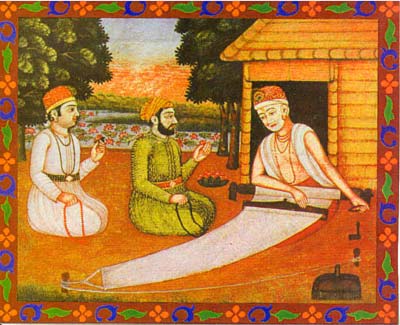What is Veda?
“Veda” is derived from “vid” which means “to know.” So, Veda means and includes all knowledge, Jnana. Man is distinguished from other animals by the Jnana that he is
endowed with. Devoid of Jnana, he is but a beast, a pasu.
endowed with. Devoid of Jnana, he is but a beast, a pasu.
Neglect of Vedas is cause for spiritual decline
The Vedas seek to promote good thoughts;
eliminate ideas of evil, and
help mankind to lead the good life.
help mankind to lead the good life.
Hence they have to be cherished and fostered
Vedah ( Veda ) are four in numbers. Every Vedah ( Veda ) has three sections namely Mantra section , Brahman section and Gyana section. The Mantra section is also called Sanhita (which means collection) section. Sanhita section gets its name from the fact that it is collection of Mantras.
Mantra section contains prayers of cosmic powers as Manifestation of Brahm(GOD). Brahman sections are also referred to as Karm Kaand and Gyan section is referred to as Upnishad. Brahman section deals with the use of the mantras in the perfomance of non-violent rituals in yagya. Upnishads(Vedanta) deal with the philosophical knowledge and worship of Unmanifest Brahm (GOD).
The Rig Veda is a collection of inspired songs or hymns and is a main source of information on the Rig Vedic civilization.
The Sama Veda: The Book of Song
The Sama Veda is purely a liturgical collection of melodies (‘saman’). The hymns in the Sama Veda, used as musical notes, were almost completely drawn from the Rig Veda and have no distinctive lessons of their own. Hence, its text is a reduced version of the Rig Veda.
The Yajur Veda: The Book of Ritual
The Yajur Veda is also a liturgical collection and was made to meet the demands of a ceremonial religion.
The Atharva Veda: The Book of Spell
The last of the Vedas, this is completely different from the other three Vedas and is next in importance to Rig-Veda with regard to history and sociology.
The purpose of Vedic mantras
The Vedic mantras were utilised in yagas and yajnas (ritual sacrifices) for promoting the wellbeing of society and the world. They were intended to secure timely rains so that the crops may be good and there may be prosperity all round. The mantras which form part of the Karma
Kanda (the path of rituals), were regarded as conducive to the promotion of general well-being
and happiness.
The purpose of Vedic mantras
The Vedic mantras were utilised in yagas and yajnas (ritual sacrifices) for promoting the wellbeing of society and the world. They were intended to secure timely rains so that the crops may be good and there may be prosperity all round. The mantras which form part of the Karma
Kanda (the path of rituals), were regarded as conducive to the promotion of general well-being
and happiness.
VALUE IN VEDAS
(Ref:http://www.sssbpt.info/vahinis/sathyasai/sathyasai11.pdf)
"Vetthi ithi Vedah”; Knowing, knowledge is Veda. That is to say, man can know from the Vedas, the Code of Right Activity and the Body of Right Knowledge. The Vedas teach man his duties from birth to death. They describe his rights and duties, obligations and responsibilities in all stages of life—as a student, householder, recluse and monk. In order to make plain the Vedic dicta and axioms and enable all to understand the meaning and purpose of the do’s and don’ts,the Vedangas, Puranas and Epic texts appeared, in course of time. Therefore, if man is eager to grasp his own significance and true reality, he has to understand the importance of these later explanatory compositions also.This is the reason why the ancients taught the Vedangas and other related texts even before the pupils learnt the Vedas. This was a must in the Gurukulas or Hermitage Schools of the past. In those days, the Bharathiyas studied the "Fourteen Vidyas” or “Subjects.” The Vedas were learnt by rote. The master of the Vedas, who had learnt the Vedas in this manner was called Jada, or Inert. But the word did not convey the meaning that he had not known anything. It only meant that he had nothing more to learn and was therefore “inactive” and “content.” Through the study of the Vedas, he had become the master of all knowledge. In order to make this human career worthwhile, the study of the Vedas was considered very essential."





0 Comments